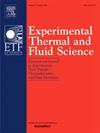双组分非混相混合喷雾的闪光辅助雾化研究
IF 3.3
2区 工程技术
Q2 ENGINEERING, MECHANICAL
Experimental Thermal and Fluid Science
Pub Date : 2025-04-06
DOI:10.1016/j.expthermflusci.2025.111492
引用次数: 0
摘要
本文采用水和己烷的混合物,在不使用表面活性剂的情况下,研究了非混相双流体喷雾的闪光辅助雾化。将等量的每种液体分别加热到己烷沸点以上(69℃)的相同温度,快速混合并通过一个小喷嘴喷射到大气环境中。结果与单流体正己烷和水的计算结果进行了比较。在不同的下游和径向位置采用高速成像和相位多普勒粒子分析仪(PDPA)测量来绘制喷雾形态和液滴特征。当温度超过单一流体或混合物中的一种流体的沸点时,在喷雾的近场观察到膨化现象。这一现象使喷雾范围明显变宽,不混相水-己烷的喷雾宽度和液芯长度介于纯己烷和水之间。PDPA的新发现表明,膨化现象导致了非混相混合物的不稳定性,因为己烷气泡的爆炸促进了喷雾混合,减小了液滴尺寸,增加了液滴速度。来自蒸发组分的气泡微爆炸是闪光辅助雾化机制的基础,在非混相混合物中,通过喷雾膨化诱导的脉动破裂导致额外的不稳定性,最终改善混合物中两组分的破裂和破碎,在一定频率下产生细液滴簇。该结果提供了利用流体之间的不混相进一步辅助过热喷雾雾化的潜力。本文章由计算机程序翻译,如有差异,请以英文原文为准。
On the flash-assisted atomization of a two-component immiscible mixture spray
This paper employs blends of water and hexane to study the flash-assisted atomization of immiscible two-fluid sprays without the use of surfactants. Equal volumes of each fluid are heated separately to the same temperature above the boiling point of hexane (69 °C), mixed quicky and ejected through a small nozzle to the atmospheric environment. The results are compared with those obtained for single fluids of hexane and water. High-speed imaging and phase Doppler particle analyser (PDPA) measurements at different downstream and radial locations were taken to map the spray morphology and droplet characteristics. A puffing phenomenon was observed in the near field of the spray when temperatures exceed the boiling point of the single fluid or one of the fluids in the blend. This phenomenon significantly widens the spray, with the spray width and liquid core length of the immiscible water-hexane falling between those for pure hexane and water. A novel finding from the PDPA results indicate that the puffing phenomenon induces instabilities in the immiscible blend as the explosions of hexane bubbles promote spray mixing, decreasing the droplet size and increasing the droplet velocity. Micro-explosion of bubbles from the evaporating component underlies the mechanism of flash-assisted atomization and this, in immiscible blends, results in additional instabilities through spray puffing induced pulsating breakup which eventually improves the breakup and fragmentation of both components in the mixture, producing clusters of fine droplets at a certain frequency. The results provide the potential of utilizing the immiscibility between fluids to further assist the atomization of a superheated spray.
求助全文
通过发布文献求助,成功后即可免费获取论文全文。
去求助
来源期刊

Experimental Thermal and Fluid Science
工程技术-工程:机械
CiteScore
6.70
自引率
3.10%
发文量
159
审稿时长
34 days
期刊介绍:
Experimental Thermal and Fluid Science provides a forum for research emphasizing experimental work that enhances fundamental understanding of heat transfer, thermodynamics, and fluid mechanics. In addition to the principal areas of research, the journal covers research results in related fields, including combined heat and mass transfer, flows with phase transition, micro- and nano-scale systems, multiphase flow, combustion, radiative transfer, porous media, cryogenics, turbulence, and novel experimental techniques.
 求助内容:
求助内容: 应助结果提醒方式:
应助结果提醒方式:


